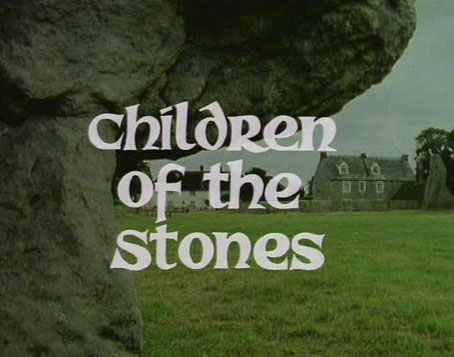
“Pretty phantasmagorical!” says precocious teenager Matthew when he and his father drive into the fictional village of Milbury in the opening scene of Children of the Stones. Matthew’s father is a scientist whose work requires a three-month stay in a village built in the centre of a series of ancient ramparts and stone circles. Once settled they find many of the villagers to be blandly cheerful, while Matthew discovers that his maths skills at the local school pale beside younger children who can solve complex equations with ease. Omnipresent characters in the village are Hendrick, a retired astronomer who owns the local manor house and acts as village squire, Margaret, a newly-arrived archaeologist who knows the history of the stones, and Dai, a vagrant poacher who lives outside the circle, and who seems eager to remain free of the Stepford-like happiness afflicting his neighbours.
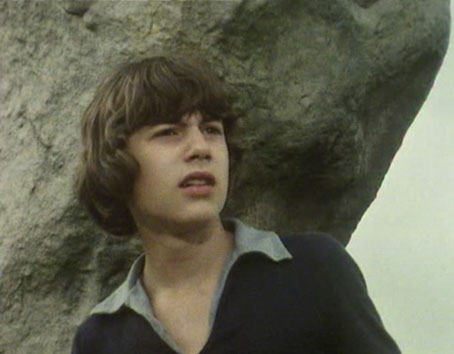
Matthew (Peter Demin).
Matthew’s “phantasmagorical” epithet is directed at the neolithic mound outside the village but could easily apply to the whole of this seven-part serial which I watched again recently. It was an HTV production first broadcast in early 1977 and I’d not seen any of it since that time. A mystery serial for children involving pagan history, folk rituals and an undercurrent of science fiction wasn’t such a surprising thing in the 1970s, this was a decade when a popular interest in the occult and the paranormal was more prevalent than at any time before or since. Children’s television reflected adult trends which is why we got to see an adaptation of Alan Garner’s The Owl Service, the occult adventure series Ace of Wands (with its hero named “Tarot”), The Tomorrow People (which occasionally strayed from science fiction to science fantasy) and others (see an earlier post, Occultism for kids). Children of the Stones was the most complex of all of these, a well-crafted drama with similarities to Nigel Kneale’s TV plays, The Wicker Man and The Prisoner. With a slight change of emphasis it would have worked just as well as a serial for adults. The best children’s serials of the period were usually adaptations of novels; Children of the Stones was an original work for television, written by Jeremy Burnham & Trevor Ray, and directed by Peter Graham Scott.
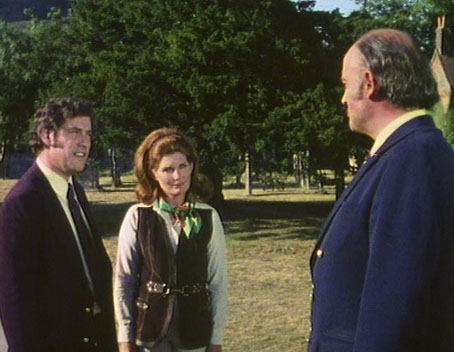
Adam (Gareth Thomas), Margaret (Veronica Strong) and Hendrick (Iain Cuthbertson).
I felt almost duty-bound to give the serial another look since it recently became a key referent in the Hauntological world alongside The Wicker Man, Nigel Kneale’s TV plays, and other film and television oddities from the 1960s and 1970s, many of which concern what Rob Young calls the Old, Weird Britain. Beyond its story, much of the cult reputation of Children of the Stones derives from its being remembered as “the scariest thing ever”, a reaction that meant little to me since I was 14 at the time and already watching adult horror films. My memories were of the use of the village of Avebury and its neolithic stones as the location for Milbury, and Sidney Sager’s extraordinary vocal score which would be a welcome contribution to any adult drama, never mind a children’s serial. I’m surprised that I didn’t remember more detail considering I was reading a lot of science fiction at the time. Children of the Stones achieves the same blend of pagan myth and cosmic sf that Nigel Kneale created for the final Quatermass outing in 1979. I’d argue that Burnham and Ray managed this much more successfully than Kneale whose drama had some impressive moments but was blighted by frequent absurdities, not least Simon MacCorkindale’s acting.
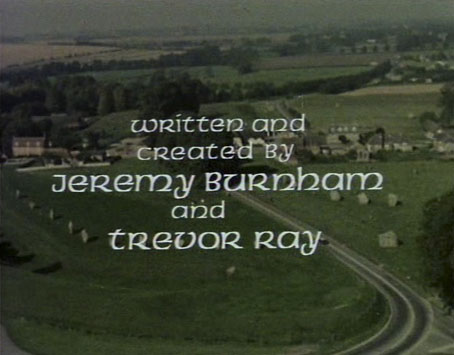
There’s a material link with Quatermass in the presence of Gareth Thomas as Matthew’s father, Adam Brake: one of Thomas’s earliest roles was as an uncredited workman in the Hammer film of Quatermass and the Pit (1967). Other parts are impressively filled by Iain Cuthbertson as Hendrick, and Freddie Jones as Dai. Cuthbertson is as perfect for the role of a genial civic leader radiating implicit threat as was Christopher Lee in The Wicker Man. Two years later Cuthbertson was bringing his same combination of charm and menace to Lawrence Gordon Clark’s updating of Casting the Runes.
Children of the Stones was a series with its own scientific advisor so the actors have to handle a lot of expository dialogue while discussing subjects such as ley lines, the alignment of ancient monuments, astronomical positioning, psychometry, the nature of black holes and the workings of atomic clocks. No wonder I didn’t remember much of the story. If the info dumps seem a little clumsy the series is remarkable for the amount of scenes where adults are discussing matters with no children present—some of these take place in the local pub with the characters all drinking alcohol—and the many throwaway incidents which few younger members of the audience would pick up on. I did remember Matthew’s comment that he ought to sell his ruined bike to the Tate Gallery: I’d been to the Tate the year before, and it was a place you never heard mentioned on children’s television. Elsewhere, Matthew remarks to his father that the Gaelic word for bear is “math”, therefore (he says) there’s a connection between mathematics and the ancient worship of Ursa Major, The Great Bear. (Matthew is another “math”, of course.) Then there’s the oddity of the scenes with Hendrick and his butler, Link. “Oh yeah,” an adult viewer might think, “two blokes living together…” The writers address suspicions with this exchange:
Hendrick: Women—delightful creatures but punctuality is not among their virtues.
Link: Yes, sir. There’s much to be said for a celibate life.
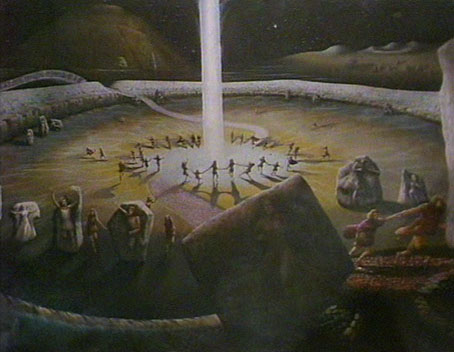
Matthew’s painting.
It’s not all maths and science: Matthew has an old painting that he bought in a junk shop which turns out to foreshadow later events. I think that and the music (and the stones themselves) caught my attention more than anything else first time round: if I’d seen that painting on a book cover I’d have bought the book.
As usual I’ve avoided revealing much of the story in the hope that curiosity is piqued enough to encourage new viewers. Yes, Children of the Stones is on YouTube but Network DVD do the whole thing in a two-disc set for a tenner. The second disc contains single episodes of other HTV serials including science fiction curio Sky. Milbury’s megaliths tower above those other productions; the reputation of Children of the Stones is fully justified.
Previously on { feuilleton }
• A playlist for Halloween: Hauntology
• The Stone Tape
• Avebury panoramas
• Penda’s Fen by David Rudkin
• Occultism for kids

If there were nothing else in the post the painting would have fostered some curiosity. I’ll have to check if the series is available in America or on our DVD format or whathaveyou. This sounds like a show I’ll enjoy and that I’d like my daughter to view when she gets a bit older. Thanks!
The painting is great. Reminded me of this classic video by David O’Reilly: https://vimeo.com/1715318 The show looks to have a bit of a ‘Chocky’ vibe.
Felix: I’d not seen the Venetian Snares before, thanks. Also don’t recall watching Chocky either although I was sharing a place at the time so TV viewing was usually subject to consensus. There’s a bit of a Wyndham feel to CotS; Midwich and Milbury can’t be too far from each other in the imaginative landscape.
I remember this as being brilliant at the time – I would have been 14 or 15 – although I’ve never come across any mention of it since, till now. WIll have to get the DVD.
Iain Cuthbertson was everywhere on upmarket kids’ telly at the time. Always a sure sign of quality. Don’t recall Freddie Jones in it, but he’d be a bonus.
I’d also forgotten about Freddie Jones until his leering face appeared accompanied by shouts from Sidney Sager’s singers. It was moments like this which probably traumatised younger viewers.
Hi John,
I just finished the series last night. My wife bought me the DVD for Xmas an a friend and I had been watching an episode every time he came over. It was wonderful, can’t say how much I enjoyed it.
Thanks for posting this as I don’t know when or if I would have heard of it otherwise. It would have been a shame to miss!
Thanks, always good to hear that people have enjoyed recommendations.